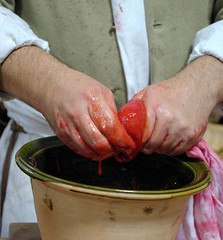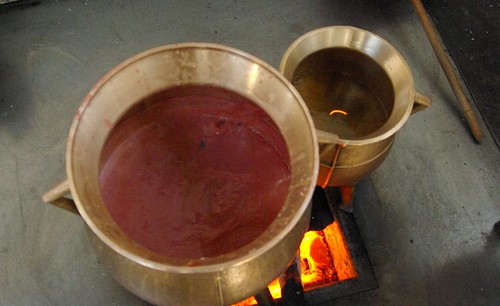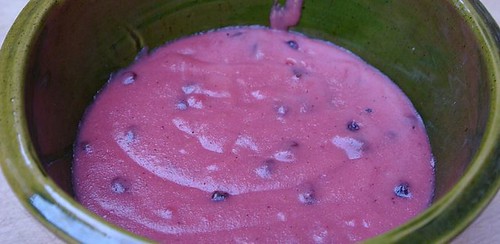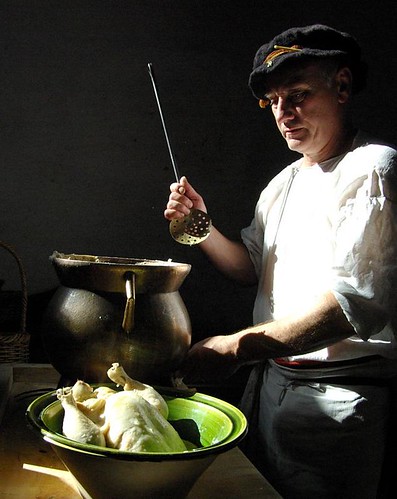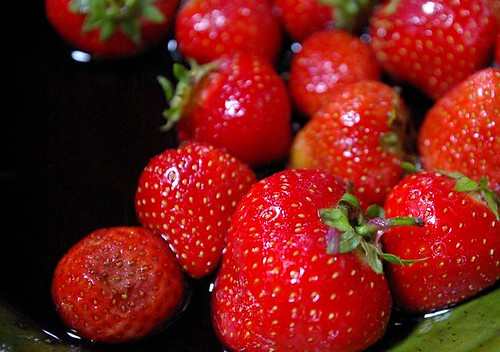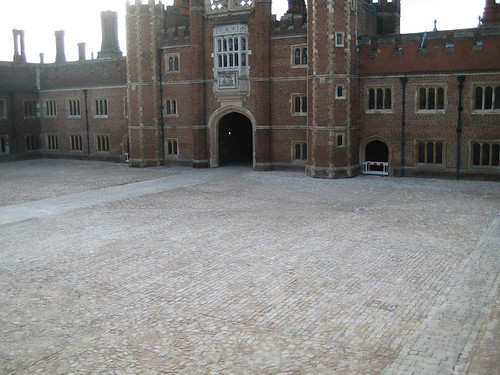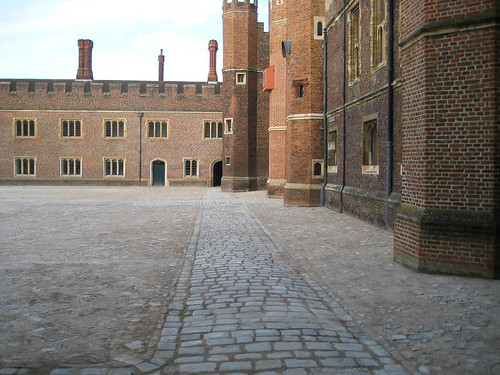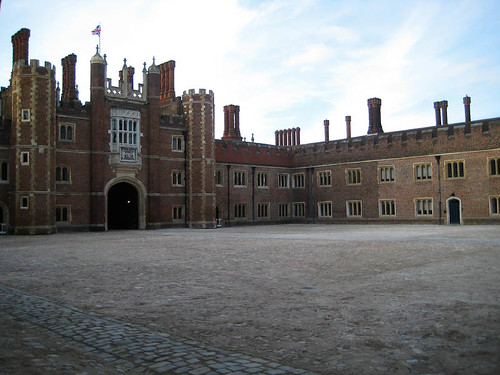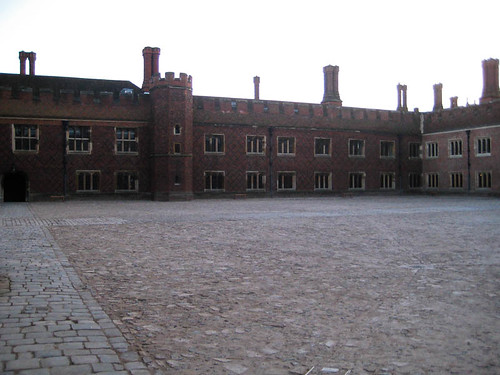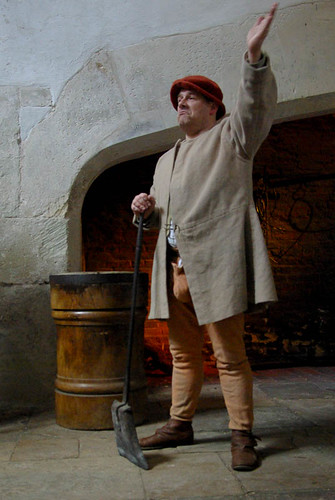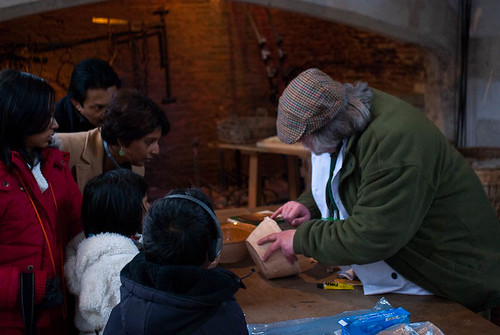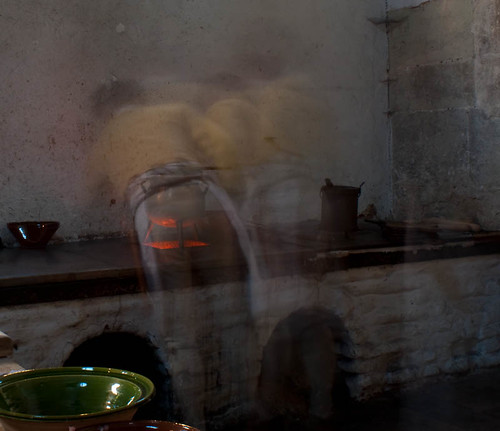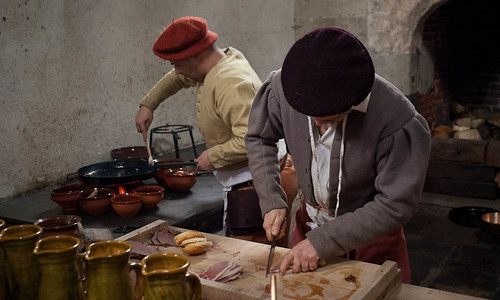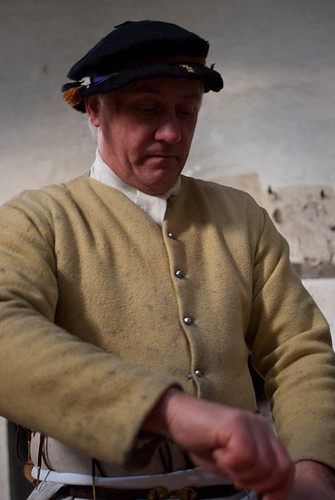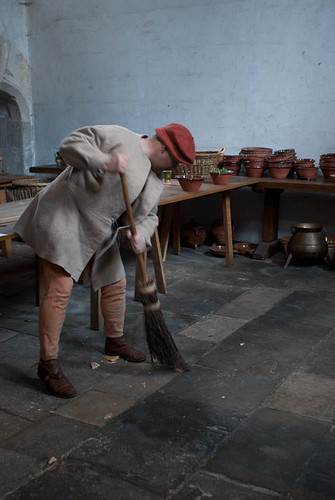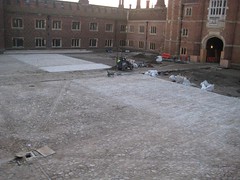A veritable essay from Robert ;-) ........there are accompanying images to this now over at Flickr.....enjoy!
For four days, spread over three cookery events, we devoted rather a long time making rather ordinary looking, rather gooey sticky sweet things. Next to the great roasts, vyande de cipres may look a bit underwhelming; but making it became one of the most interesting, and perhaps important experiments we have undertaken.
It's one of those recipes that occurs early on; it is mentioned in the first english menu, thirteenth century, and can be followed up through the years, changing a bit each time. It seems to be an anglo-norman innovation; Hieatt and Butler couldn't find a french source version, despite its name. 'Vyande'; meat, food, and 'cipres', meaning sweet, as Cyprus was known as a supplier of sugar. Sweetmeat. Although the oldest recipe has almond milk, rice flour, ginger and, bizarrely, pistachio nuts; but no sugar. The sweetness is provided by gingerbread, made from breadcrumbs and honey, although as it is strewn over the unspecified combination of the other ingredients, it wouldn't strike us as being overly sweet. Or would it?
Ever since food history has been taken seriously, the big question has been how these dishes tasted to the diners of the past? For example, the recipe above says to add ginger so 'that hit smacche wel of the gynger'. When spice was rare and expensive, what does that mean? It also states that it is the colour yellow, without saying how.
The other versions of this become more complicated, introducing meat and more spices. In the Forme of Cury it's dates, mead or sweetened wine, unspecified spice powder, then thickened so that it is 'stondyng'. If you are in the mood, and it is out of lent, add boiled chicken and pork... Not bad, but the thing to remember about the Forme of Cury, is that it's not just one book, but a group of manuscripts. The chosen version in 'Cury on Inglysch' is the one above, with dates. However in other manuscripts, which are all 'Forme of Cury', the dates are missing, instead we have; 'ootmele', 'mele', melis', 'me dates', 'damasines'. We are still asked to pike out the stones though; works for the damsons or plums, not so useful for the oatmeal. Pegge's in 1780 had 'oot mele', and the excellent online version posted by John Rylands University Library has 'mele'.
Our usual one, from 'Two Fifteenth Century Cookbooks', in it's turn, a bit more detail, Wine, suger, ginger, galengale, canel, parsely juice, rice flour, ground chicken and egg yolkes. And coloured with saffron and sandlewood. Even this one is a bit unformed, there is an instruction to make it 'chargeant', but is is unclear whether the rice or the eggs are responsible.
Recipes like this are are so frustrating, they are obviously meant to be special and expensive, but the absence of quantities and method makes it difficult to do them justice.
So when we realised that we had a measured recipe for the 'Vyande', would this mean that we had a clue at last to how sweet and spicy these dishes really were?
The collection that it is part of was published in London by Richard Pynson in 1500, and is obscure enough to have earned itself a rather legendary status. It is not, however, quite the missing link between the mid 15th Century manuscripts, and the popular Elizabethan cooking books, that we thought it may have been.
It's a printed version of an existing manuscript, and is almost identical to the manuscript edited by Robina Napier in 1882. First pointed, out I think, in the introduction to the Austin 'Two Fifteenth-Century Cookery Books, 1888, and by Hazlitt, but unremembered since, perhaps. The 'Napier' as we have named it among ourselves, is now available to study on the excellent 'Medieval Cookery' website.
The 'Napier', and the 'Pynson' both start by describing themselves as a 'noble' book, for a princes household, and then list the dishes at a feast by Henry the Forth. The 'Pynson' then does the same for a few more impressive feasts, including an enthronement of a Bishop of London in 1407. Very much like the late medieval cookbooks. Then the books come together with the enthronement of the Archbishop of York, named as Neville by 'Napier', dated to 1465 by 'Pynson'. This is the feast explored at some length in Warner's 'Antiquitates Culinariea', 1791, or it should be; the dishes don't seem to match...
Robina Napier is of the opinion that the handwriting of her manuscript would, 'but for the mention of this feast, point to an earlier date.'
Anyway, back to the Vyande de Cipres, there are two recipes in the 'Pynson', and one is common to both books, and is of the 'meaty' variety, in this case capon or chicken. Boiled and ground, cooked with almond milk and starch or rice flour, coloured with saffron, seasoned with sugar and 'florysshed' with almonds.
So, we still don't know exactly how this is supposed to be, sweet and chickeny presumably. At least the yellow colour is explained this time.
Right at the end of her book Mrs. Napier informs us that according to a contents list there are 'twenty-seven recipes unfortunately wanting in the manuscript'. Luckily, these twenty-seven are not missing from Pynson's version.
Which is brilliant; there are some very interesting recipes in these twenty-seven, I got rather excited about 'Potage of Ynde', surely not a fifteenth-century curry! Not I'm afraid, it's indigo... mmm...
But the one that all this is leading up to is... 'For to make vyande de cypres for xl messe'.
So it's the Vyande again, but this one has quantities, not for all the ingredients, but useful enough; so will we at last have an indication to how sweet and spicy something is? Here it is in full...
'To make viande de cipres for fourty messe / take viii. pounde of pruynes & ii. galons of vernage and make therof a thicke mylke / than take iii. pounde of dates & bete them in a morter but perboule them fyrst with vernage & drawe it up with a wide streyner & put the mylke in a potte & sette it on the fyre to boyle & caste therto iiii. pounde of suger cipres & a quart of pouder ginger half a quarter of canell drawen through a cloth wt wyne than take floure of rise drawen with wyne & put al in the pot & stire it togeder and colour it lightly wyth saffron & salt it & dresse v. or vi. leskes in a disshe for a lorde and take suger plat Rosenyg / and pouder og gynger medled with sugar & serue it'
Wow, measures! For the first time our tudor cooks have a chance to make something with a clue to how sweet and spicy a dish is supposed to be. Robin and Marc were getting rather excited about this and couldn't wait to have a go.
First the calculations had to be done... We used the american gallon of eight sixteen ounce pints, 3.78 litres, although 3.67 may be closer to the fifteenth century gallon; when we do it again we'll find out a bit more about this. And how many people is forty messes, a mess could be four or six people; we took it to be four, this of course will only affect the amount of sugar and spice per person, not the overall sweetness, etc.
So, per mess;
Prunes 3.2oz 90g
Vernage 6.4floz 181ml
Dates 1.2oz 34g
Sugar 1.6oz 45g
Ginger 0.1oz 2.8g
Canel 0.05oz 1.4g
That is 11.3g of sugar per diner; which is a heaped dessert spoon, already we can tell this is going to be rather sweet! Especially as vernage is sweet wine anyway. Very roughly, using the prices of goods from the time of Henry the Eighth quoted by Pegge, the price per mess is about 2 ½ d.
Incidently, this is the only version that calls for 'suger cipres', was this really a commodity of the time, since the the thirteenth century when these 'Vyande de Cipres' recipes first appeared? Was it added as part of the revision process as these recipes were 'updated'? This raises the question of what these recipes actually are, even whether they were meant to be made at all... A question for another time, perhaps...
Saturday 24th October, Robin had a go. We weighed out the ingredients, enough for two messes. The first part looks quite straightforward, at first make a milk of the prunes and wine. Then beat the dates in a mortar, but by the way, boil them first, does this mean the prunes too? Why the wide strainer; as in coarse, for texture, or very wide as a quick way to remove the stones, could save time when making a dish for 120 people. Added ginger and cinnamon, and the rice flour with some extra wine, and heated to cook the rice flour. As usual, just when things are looking well, something crops up, in this case the saffron to 'colour it lightly'. But this is a mush of prunes and dates, how can this be coloured in any meaningful way with saffron?
Turned out very interesting, it was too sticky to make convincing slices, but it was very sweet, and very gingery. Not very impressive looking, but it was our first taste of how sweet a sweet dish was supposed to be. We thought that if people in the past hadn't had a diet heavy in sugar since they were born, like us, their sweets would seem to us rather insipid; not so!
Next day, having seen the first version, both Robin and Marc rolled their sleeves up, and made separate dishes, trying different techniques from their years as historic cooks. As the details are rather important, and my notes don't really do them justice, I'll get in touch with them first, and get their methods properly recorded, as things got a bit complicated!


